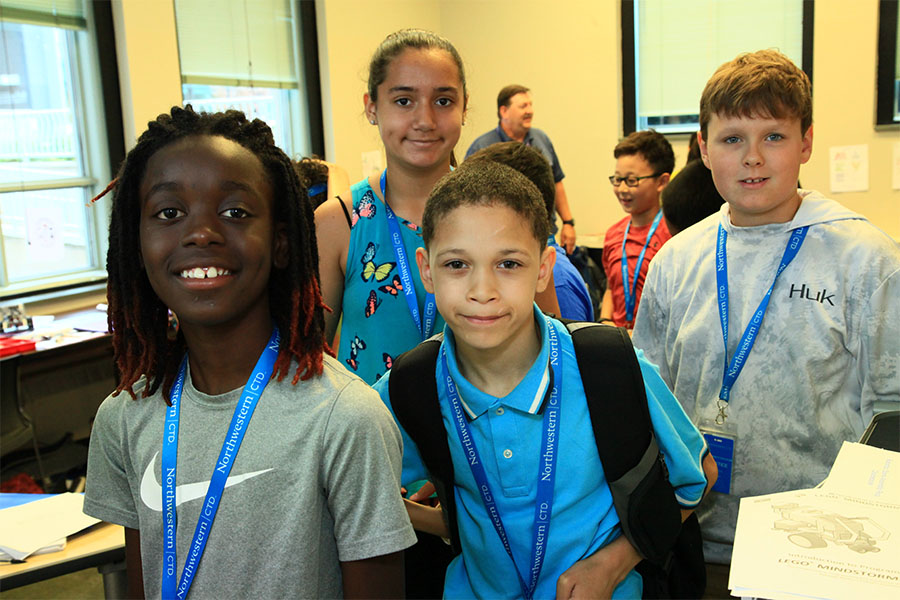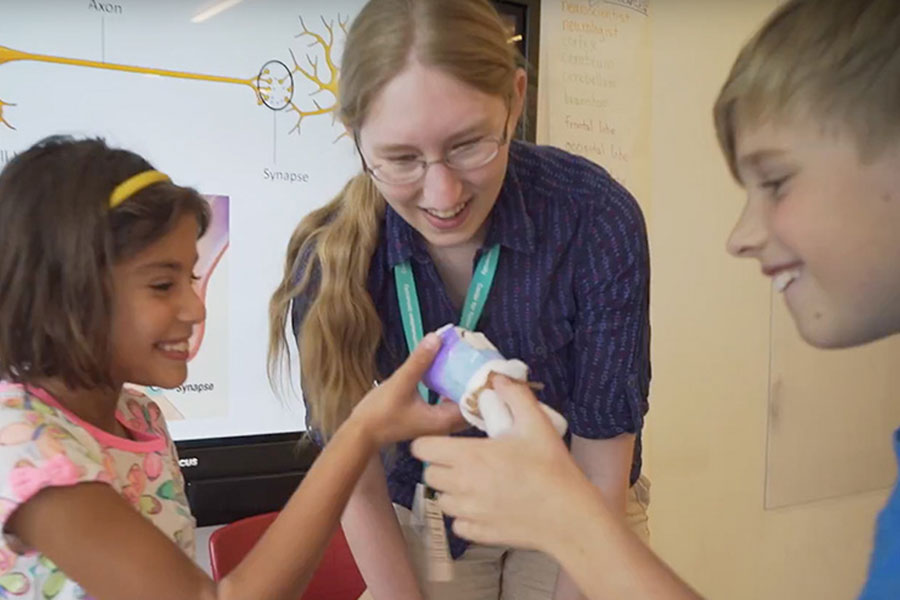By Amy Jacobs, Saturday Enrichment Program Instructor, Center for Talent Development

What is it about magic that makes it so appealing to us? A good magic trick transports us back to that place in our lives when everything was filled with wonder. We wonder how the magician did their trick; it seems impossible, yet we saw it with our own eyes!
Have you ever wondered how a magician could pull a tablecloth off a table without spilling a drop of milk? What about the magician who pours a glass of milk into the newspaper and then, “poof” there’s no liquid there? Wouldn’t it be exciting to make a paperclip dance or inflate balloons with just a flick of the wrist?
The truth is that good magicians are masters of distraction and redirection; however, they also must have an understanding of various principles of science. But why is it necessary to understand scientific principles to properly create magic tricks?
To be successful, magicians must learn how to manipulate the physical world so that they can create the illusion of magic for you.
Science in magic is a topic I will explore with students in grades 4 through 6 at CTD’s June 29
Opportunities for the Future Conference for gifted students and their families. While workshop participants won’t emerge as the next Houdini, students will come away with a better idea of States of Matter, Gravity, Surface Tension, Magnetism, and Optical Illusions. Just understanding these scientific principles will help aspiring magicians create some remarkable effects.
To whet your appetite here is a sample of the type of “magic” tricks we will learn to perform.
Amazing powerful water!
Materials:
- Large glass
- Water
- Index card
- Towel (just in case…)
- A volunteer who doesn’t mind the risk of getting a little wet.
Steps:
1) Fill the glass about 2/3 full of water. Tell the audience that using an index card we will flip the glass over and not spill a drop!
2) Show the audience the index card. Place the index card over the top of the glass, completely covering it. Ask for a volunteer who is willing to risk having the glass of water flipped over their head.
3) Holding our palm over the top of the glass and the card, we quickly flip the glass over and take our hand away from the index card. If we have done the trick correctly (and I’m confident we will) the volunteer will not get wet. How it works: In addition to water, there is air in the glass. Both air and water exert pressure. The air outside the glass will be pushing up on the index card with more force than the water in the glass is pressing down.
Science is magical and magic is science. There are great lessons and “ah-has” to be gained by exploring the world of science through the fun and surprising realm of magic.
The CTD Opportunities for the Future Conference, taking place on the Evanston, Illinois campus of Northwestern University, offers stimulating workshops and presentations designed to help gifted students and their parents plan for the future. Adults attend a keynote address and subsequent presentations while students in grades 4 through 12 enjoy interactive workshops that focus on interesting fields of study and future career paths. Children age 4 through grade 3 are invited to participate in supervised activities while family members visit sessions. Full information about the conference is on the
CTD website.
Amy Jacobs has been an instructor for
CTD’s Saturday Enrichment Program since 2010 and is teaching a course for
CTD’s 2013 Summer Program. She is an author on topics in education and an adjunct professor at College of Lake County.
 What is it about magic that makes it so appealing to us? A good magic trick transports us back to that place in our lives when everything was filled with wonder. We wonder how the magician did their trick; it seems impossible, yet we saw it with our own eyes!
Have you ever wondered how a magician could pull a tablecloth off a table without spilling a drop of milk? What about the magician who pours a glass of milk into the newspaper and then, “poof” there’s no liquid there? Wouldn’t it be exciting to make a paperclip dance or inflate balloons with just a flick of the wrist?
The truth is that good magicians are masters of distraction and redirection; however, they also must have an understanding of various principles of science. But why is it necessary to understand scientific principles to properly create magic tricks?
To be successful, magicians must learn how to manipulate the physical world so that they can create the illusion of magic for you.
Science in magic is a topic I will explore with students in grades 4 through 6 at CTD’s June 29 Opportunities for the Future Conference for gifted students and their families. While workshop participants won’t emerge as the next Houdini, students will come away with a better idea of States of Matter, Gravity, Surface Tension, Magnetism, and Optical Illusions. Just understanding these scientific principles will help aspiring magicians create some remarkable effects.
To whet your appetite here is a sample of the type of “magic” tricks we will learn to perform.
Amazing powerful water!
Materials:
What is it about magic that makes it so appealing to us? A good magic trick transports us back to that place in our lives when everything was filled with wonder. We wonder how the magician did their trick; it seems impossible, yet we saw it with our own eyes!
Have you ever wondered how a magician could pull a tablecloth off a table without spilling a drop of milk? What about the magician who pours a glass of milk into the newspaper and then, “poof” there’s no liquid there? Wouldn’t it be exciting to make a paperclip dance or inflate balloons with just a flick of the wrist?
The truth is that good magicians are masters of distraction and redirection; however, they also must have an understanding of various principles of science. But why is it necessary to understand scientific principles to properly create magic tricks?
To be successful, magicians must learn how to manipulate the physical world so that they can create the illusion of magic for you.
Science in magic is a topic I will explore with students in grades 4 through 6 at CTD’s June 29 Opportunities for the Future Conference for gifted students and their families. While workshop participants won’t emerge as the next Houdini, students will come away with a better idea of States of Matter, Gravity, Surface Tension, Magnetism, and Optical Illusions. Just understanding these scientific principles will help aspiring magicians create some remarkable effects.
To whet your appetite here is a sample of the type of “magic” tricks we will learn to perform.
Amazing powerful water!
Materials:

